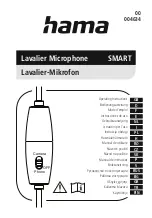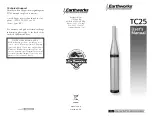
Description
The R-122V is a compact, active, bi-directional (figure-eight)
velocity type tube ribbon microphone designed for professional
applications. The figure-eight pickup pattern allows the R-122V
to be addressed from either side with equal sensitivity. The in-
phase signal is achieved when the microphone is addressed from
the front, indicated by the “ROYER” logo.
The R-122V is reasonably tolerant of shock and vibration, and
performance is unaffected by changes in temperature or humidity.
However, ribbon microphones are somewhat more sensitive to
direct blasts of air and the R-122V is no exception to this rule.
Discretionary use of a windscreen or pop screen, such as the
Royer PS-101, WS58 or equivalent, is highly recommended for
close-miking vocalists or certain types of percussion and wind
instruments.
Applications
The Royer Labs model R-122V is a versatile microphone and is
ideally suited for many critical recording applications. Its smooth
frequency response characteristics and ability to capture detail
make it a fine choice for many instruments, as well as for general
broadcast applications. Its gentle low-frequency proximity effect
makes it especially useful for vocalists and announcers. Female
vocalists often benefit from the R-122V’s ability to capture high
frequencies without distortion or edginess. Orchestral instruments
are captured in a natural-sounding way, free from microphone-
induced “hype.” The R-122V has exceptionally smooth high
frequency characteristics and is devoid of microphone induced
ringing. Phase-related distortion and irregular frequency peaks
are conspicuously absent. These features make the R-122V
vacuum tube ribbon microphone an ideal choice for strings,
woodwinds, percussion and amplified instruments. Theater organs
and electric guitar amplifiers sound big and fat, without unnatural
coloration, when recorded with the R-122V. Acoustic pianos can
be captured accurately without the comb-filtering effects associated
with condenser microphones.
5
Summary of Contents for R-122V
Page 31: ...Polar Pattern Frequency Response 30 ...
Page 32: ...Notes 31 ...







































